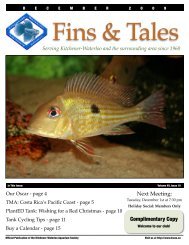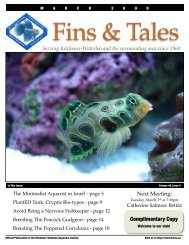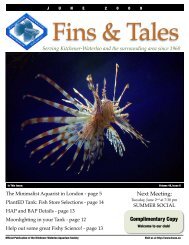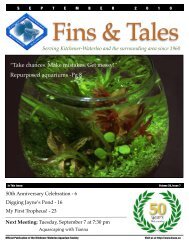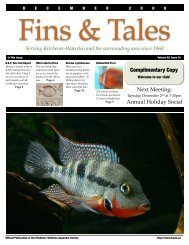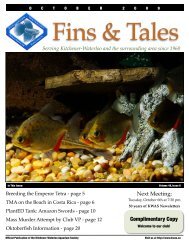April 2009 - Kitchener Waterloo Aquarium Society
April 2009 - Kitchener Waterloo Aquarium Society
April 2009 - Kitchener Waterloo Aquarium Society
Create successful ePaper yourself
Turn your PDF publications into a flip-book with our unique Google optimized e-Paper software.
A P R I L 2 0 0 9<br />
March Name That Fish<br />
Submitted by Zenin Skomorowski, KWAS (zenin@golden.net). All photos by the author.<br />
Dwarf Flag Cichlids ( Laetacara curviceps ) Family of Brevis ( Neolamprologus brevis )<br />
This month’s first “Name That Fish” was a group of four<br />
Dwarf Flag Cichlids guessed by Jamie McDougall.<br />
They originally come from slow moving tributaries in the<br />
Amazon basin. Most of these fish seen in the hobby are captive<br />
bred on commercial farms or by hobbyists. They are<br />
omnivores, so part of their diet should contain meaty high<br />
protein foods like pellets, flakes and occasionally live and<br />
frozen foods. Vegetable flake, spirulina and shelled frozen peas<br />
should also be given. Sexing is difficult, but you may notice the<br />
typical longer dorsal, ventral and anal fins in males. Adult<br />
males can grow to 7.5 cm (3 inches), females will grow to 6.5 cm<br />
(2.5 inches). Females may be stockier when carrying eggs.<br />
They form monogamous pairs and are substrate spawners,<br />
usually depositing eggs on a flat rock. They are diligent parents<br />
and will chase away much larger fish when protecting eggs and<br />
fry.<br />
A minimum of 20 gallons should be provided with driftwood,<br />
floating plants and a dark substrate. The water should have<br />
minimal movement and be in the acidic range of pH from 5.5 to<br />
7.0. Temperature range is 24 to 29C ( 75 to 84F ). Companions<br />
can be tetras, and<br />
pencil fish. In larger<br />
tanks, they can be<br />
with other relatively<br />
peaceful cichlids such<br />
as angels, discus and<br />
rams. Corys and<br />
dwarf plecos may eat<br />
the eggs.<br />
This month’s second “Name That Fish” was a pair of<br />
Neolamprologus brevis guessed by Ryan Barton. The fish along<br />
with the conch shell were donated by Geoff Money.<br />
These shell dwelling dwarf cichlids originally come from the<br />
Rift Lake Tanganyika in East Africa. Most of these fish<br />
available in the hobby come from local breeders. These fish are<br />
easy to breed. Provide a shell and a devoted pair will take up<br />
residence and you will have fry very soon. Males grow to<br />
about 6 cm (2.25 inches), females are smaller at 4 cm (1.5<br />
inches). They have a brown body and slightly yellow belly<br />
with 9 tan vertical bars on their sides. There is usually a<br />
florescent blue line under the eye. A dark fringe on the tail is<br />
preceded by a lighter colour band. They are not picky eaters.<br />
Give them flake, micro pellets, frozen bloodworms and brine<br />
shrimp.<br />
They rarely go more than a few inches from their shell. If you<br />
provide small shells, make sure there is a sand substrate so they<br />
can rearrange the sand and the shell to their liking. Water<br />
parameters should be hard with a high pH, <strong>Kitchener</strong>-<strong>Waterloo</strong><br />
tap water is ideal. Temperature should be 25-27C ( 77-80F ). A<br />
10 gallon tank is<br />
plenty for a pair. If<br />
kept in a larger tank,<br />
try them with White<br />
Cloud Mountain<br />
Minnows, or other<br />
small fish that will not<br />
compete for territory<br />
along the bottom of<br />
the tank.<br />
23





